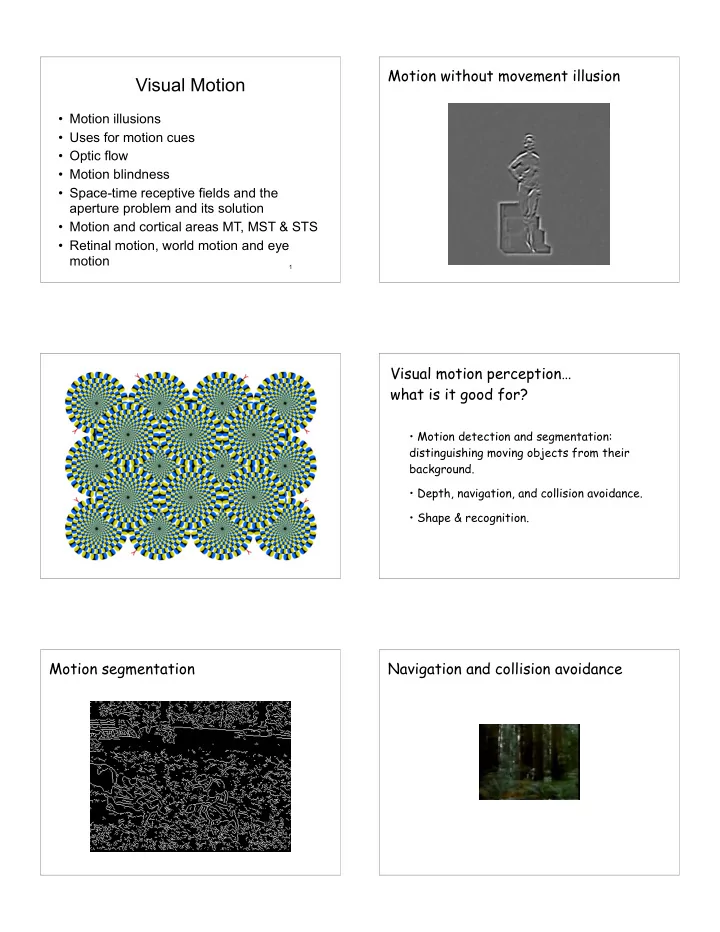

Motion without movement illusion Visual Motion • Motion illusions • Uses for motion cues • Optic flow • Motion blindness • Space-time receptive fields and the aperture problem and its solution • Motion and cortical areas MT, MST & STS • Retinal motion, world motion and eye motion 1 Visual motion perception… what is it good for? • Motion detection and segmentation: distinguishing moving objects from their background. • Depth, navigation, and collision avoidance. • Shape & recognition. Motion segmentation Navigation and collision avoidance
Depth and motion parallax Optic flow 3D Shape from motion James Gibson Recognition & biological motion Akinetopsia (motion blindness)
Cortical area MT is specialized Visual area MT for visual motion perception MST • Neurons in MT are selective for motion direction. MT MT • Neural responses in MT are correlated with the perception of motion. V3a • Damage to MT or temporary inactivation causes deficits in visual V3 motion perception. • Electrical stimulation in MT causes changes in visual motion V2 perception. • Computational theory quantitatively explains both the responses of MT neurons and the perception of visual motion. V1 • Well-defined pathway of brain areas (cascade of neural computations) underlying motion specialization in MT. MT neurons are direction-selective A Simple Way to Think About Motion: The Space/time Plot t 1 Space/time Plot Space/time Plot t 2 t 3
Space/time Plot Space/time Plot t 4 t 5 Space/time Plot Space/time Plot t 6 t 7 Space/time Plot Space/time Plot t 8 t 9
Space/time Plot Space/time Plot t 10 t 11 Space/time Plot Space/time Plot t 12 time Space/time Plot Space/time Plot time time Space
Space/time Plot Space/time Plot Real motion Real motion time time Space Space Space/time Plot Space/time Plot Real motion No motion time time Space Space How Can the Visual System Detect the Space/time Plot “Orientation” of Motion Energy in Space/Time? Real motion ! + ! ++ ! time ! ! ! Does this remind you of another aspect of neural processing that the visual NOW system accomplishes? Space
Motion aftereffect Selectivity for motion direction MAE Explanation Up Down Up Down Up Down Before adaptation During adaptation After adaptation Apparent Motion Apparent Motion frame 1 frame 2
Motion perception depends on context Motion Integration: Solve the Aperture Problem Given two orientation- and direction-selective neurons: And one complex pattern moving rigidly: The “barber-pole” illusion analyzes analyzes But it can only see: But it can only see: So its output is consistent So its output is consistent with these velocities: with these velocities: Locating Human MT The two neurons: are then integrated to analyze Resulting in the correct velocity solution:
Locating Human MT Columnar architecture in MT Motion coherence and MT neurons Motion coherence and MT neurons Motion stimulus no coherence 50% coherence 100% coherence Responses of MT neurons Preferred direction Monkeys and Electrical motion percepts stimulation in MT Microstimulate at a site in MT where the neurons prefer downward motion while monkeys make up/ down motion judgments for stimuli with various levels of coherence. no coherence 50% coherence 100% coherence
Microstimulation in MT changes motion Visual area MST and optic flow perception MST MT V3a With V3 stimulation V2 No stimulation (note bias) Visual area STS responds to Visual motion and eye movements biological motion STS MT
Recommend
More recommend